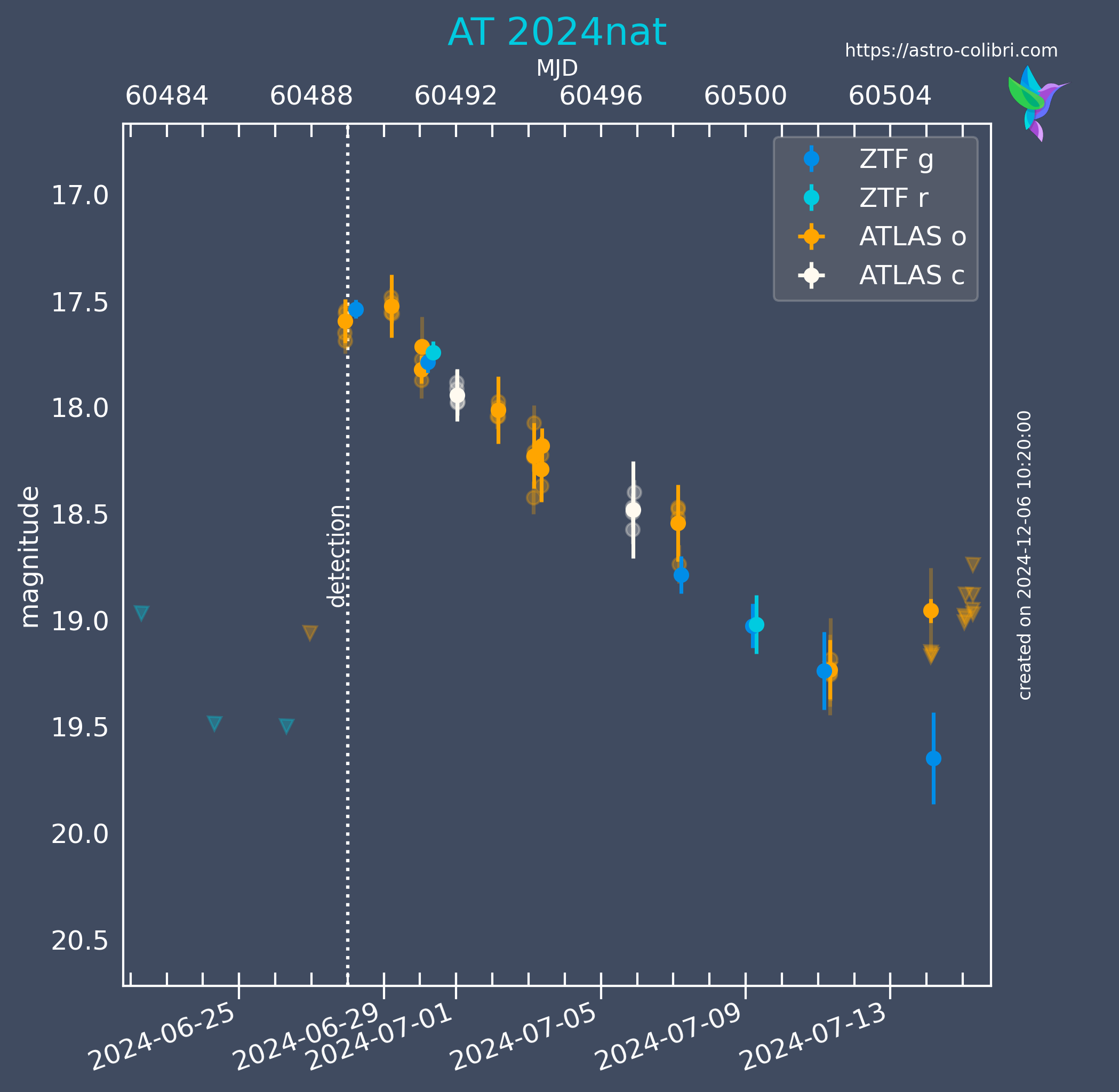lightcurves
We query the following data sources to compile the lightcurves of optical transients (introduced with v2.15.0):- Asteroid Terrestrial-impact Last Alert System (ATLAS)
- ASAS-SN
- Fink broker (access to data from the Zwicky Transient Facility (ZTF))
- Réseau Amateur Professionels pour les Alertes Scientifiques (RAPAS)
We search for the nearest source around the selected event and retrieve all available photometric observations. ZTF observations are retrieved via the Fink broker and include all available data, i.e. we do not limit ourselves to the Fink data quality criteria. It should be noted that ASAS-SN provides the raw photometric values at the location of sources in the ASAS-SN catalog while ZTF/Fink and ATLAS provide difference magnitudes after substracting archival measurements. In general this means that ASAS-SN provides combined measurement of the host galaxy and the transient, while the other observatories provide direct measurements of the luminosity of the transient event.
Finally, we apply filters to the data points of all observatories to remove entries with (mag < 0.1) as well as entries with large uncertainties (mag_err > 0.5). ATLAS measurements are combined into intervals that are 90 minutes long. The original measurements are shown with semi-transparent markers. ZTF data that is flagged by the Fink broker as 'bad quality' is also shown in the same way. Upper limits are shown as downward facing triangles. The resulting figure shows all selected datapoints. The X-axis of the figure is rescaled to match this data range and therefore does not necessarily correspond to the user-defined time range. An example of the resulting lightcurve figure is shown here:

Default lightcurves for optical transients (including all un-classified ones) detected in the last 15 days are updated once per day. All classified transients (independent of the classification, i.e. SNe, TDE, CVs, etc.) detected over the last 50 days are also updated each day. Special, nearby supernovae are updated daily for a full year. The selection is requiring the redshift to be known and to be smaller than 5% of all events with the same SN type (1% for SN Ia and SN II). The lightcurves cover 5 days before the detection of the transient and up to the day of their update. The date of the creation of the figure is given on the figure for reference. Users can create customized lightcurves by opening the small menu indicated by the downward facing arrow (in Science mode). The user can then selected the desired time range and (if sufficient access rights exist) add or remove data from observatories and amateur astronomer networks. The name of the lightcurve contains all data sources requested for its creation.
Photometric Summary
We provide key photometric data for each event, including the time, magnitude, and magnitude error for each filter and telescope (ATLAS, ASAS-SN and ZTF) if availabe. Thefirst observation is defined as the earliest measurement at or after the TNS detection time (i.e., the official event report time,
with a 12-hour window included to ensure better coverage). The peak observation corresponds to the measurement of highest brightness
(i.e., the lowest magnitude value in the light curve), and the last observation is the most recent entry in the telescope catalog.
These data points serve as sub-filters, enabling users to identify rapidly rising or fading transients, filter events by the last magnitude value,
or select events within a specific time window relative to the first, peak, or last observation.
These features are available in the latest_transients and cone_search endpoints, both in the API and the frontend interface.
We also display lightcurve slopes:
Rising (from first to peak observation) and Fading (from peak to last observation), which help users quickly characterize transient behavior, understand the evolution of the event over time, and visualize how the filters work. We require the measurement with the same filter to be taken at least 12 hours apart to calculate the slopes.
Download Full Photometry Dataset
Alongside the lightcurve figure and the condensed photometry information, a CSV file is available for download. This file contains the full dataset of photometric measurements used to generate the lightcurve figure. Each row corresponds to an individual observation and includes information such as the observation time (in both UTC and MJD formats), the filter used (e.g.,ztf_g, atlas_o), the measured magnitude and its uncertainty, and the source of the data (ATLAS, ZTF, or ASAS-SN).
A flag column is also included to indicate the quality or type of each measurement. For instance, ATLAS data may be marked as original or average depending on whether it comes directly from the catalog or is averaged across 90min intervals. These averaged values also include the uncertainty in the time. All values can also carry an ul flag to denote upper limits. In the case of ZTF and ASAS-SN, the flag may be good, bad, or ul (for upper limits), allowing users to further filter or interpret the data.
